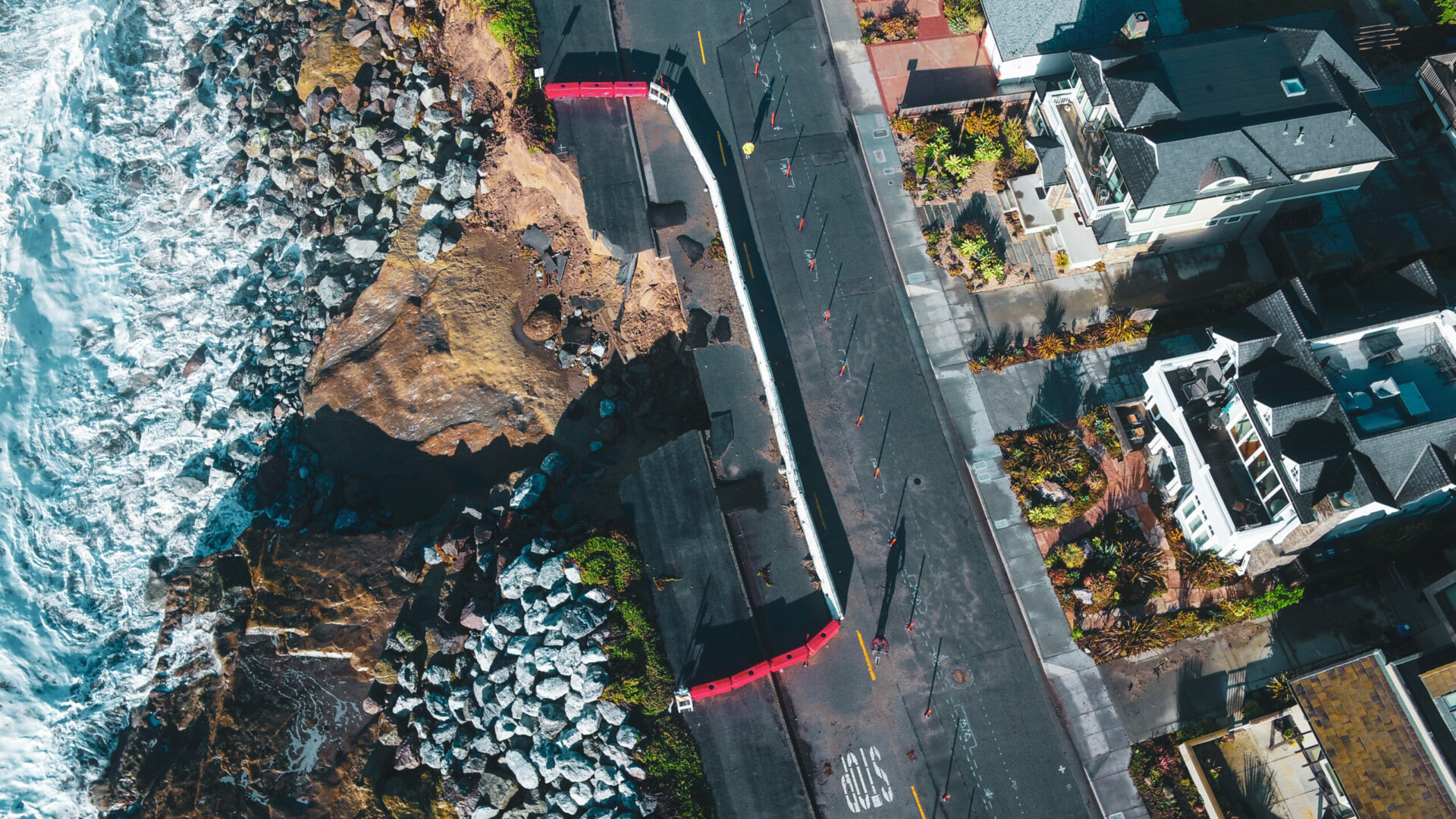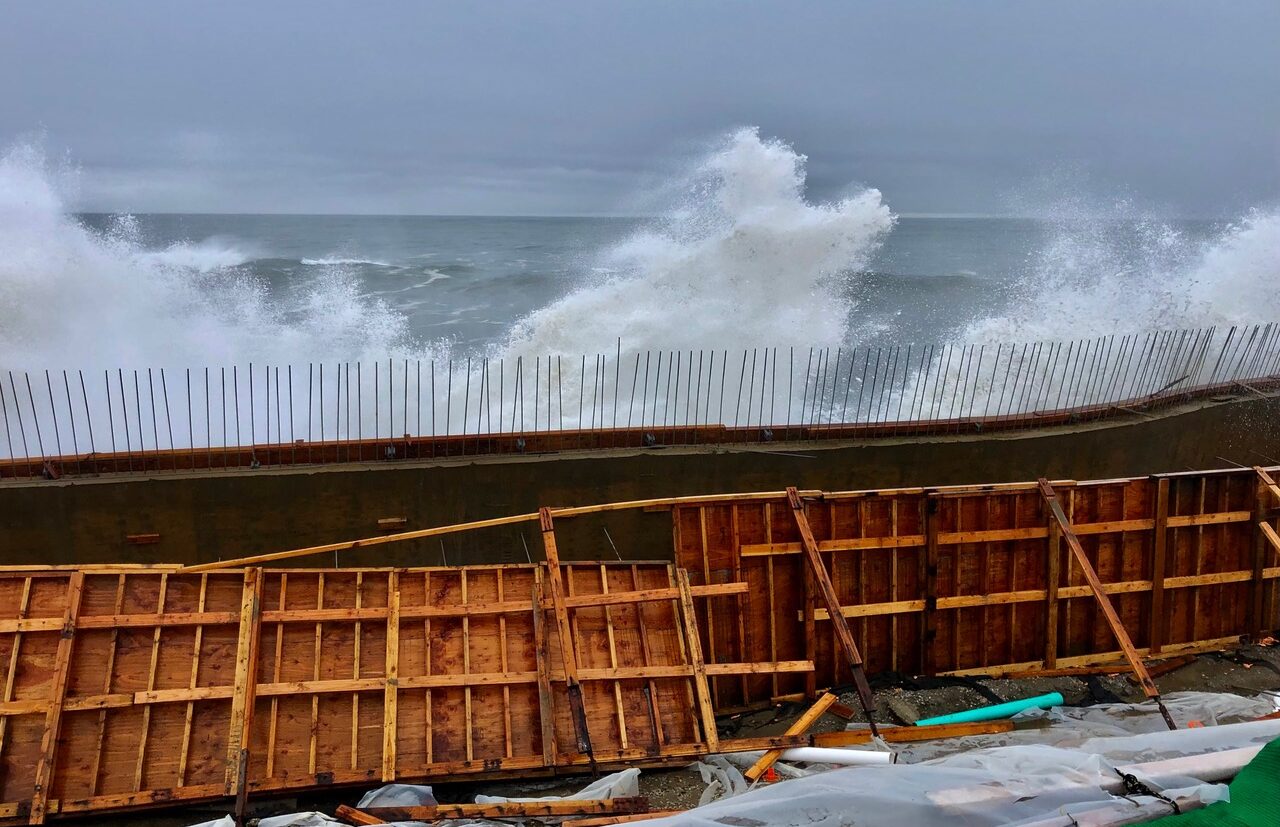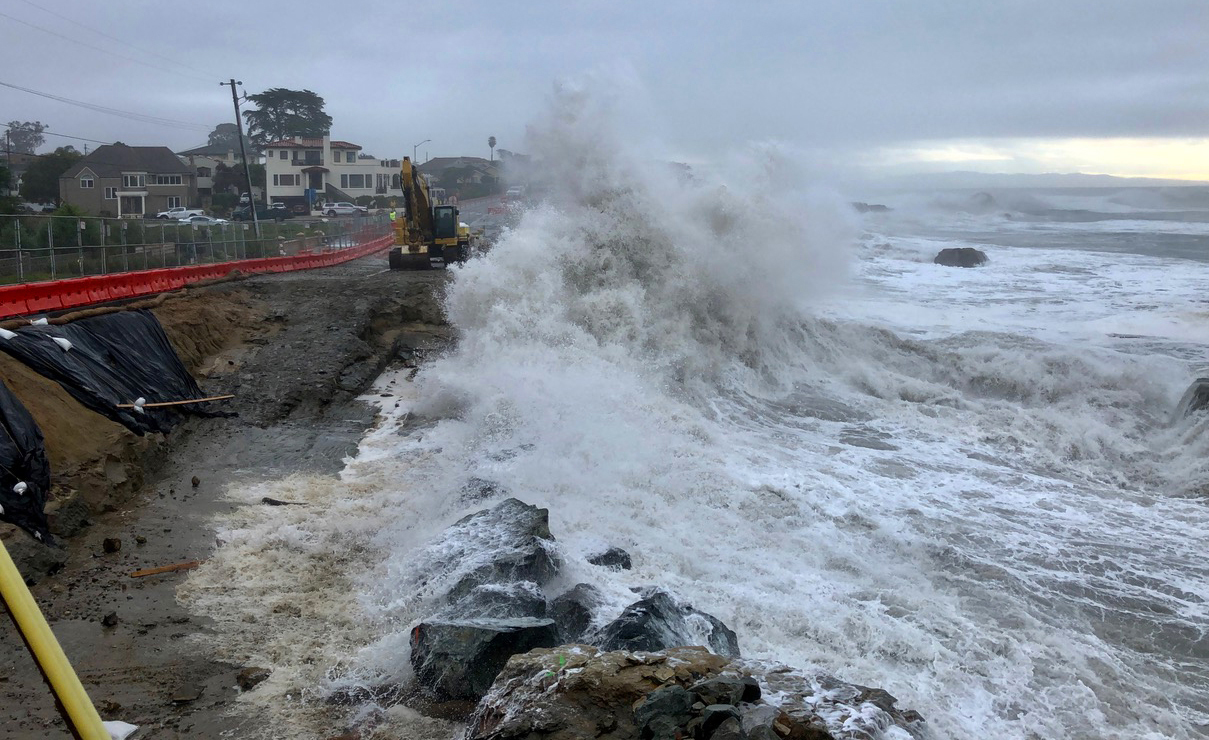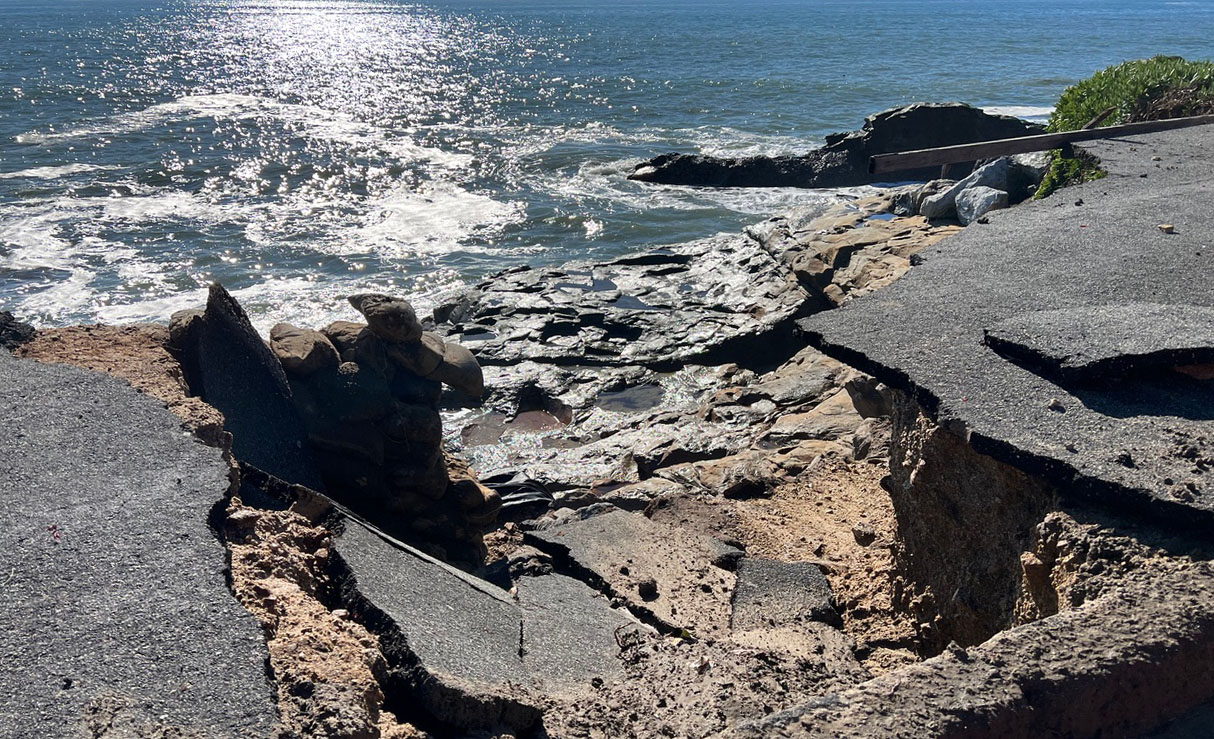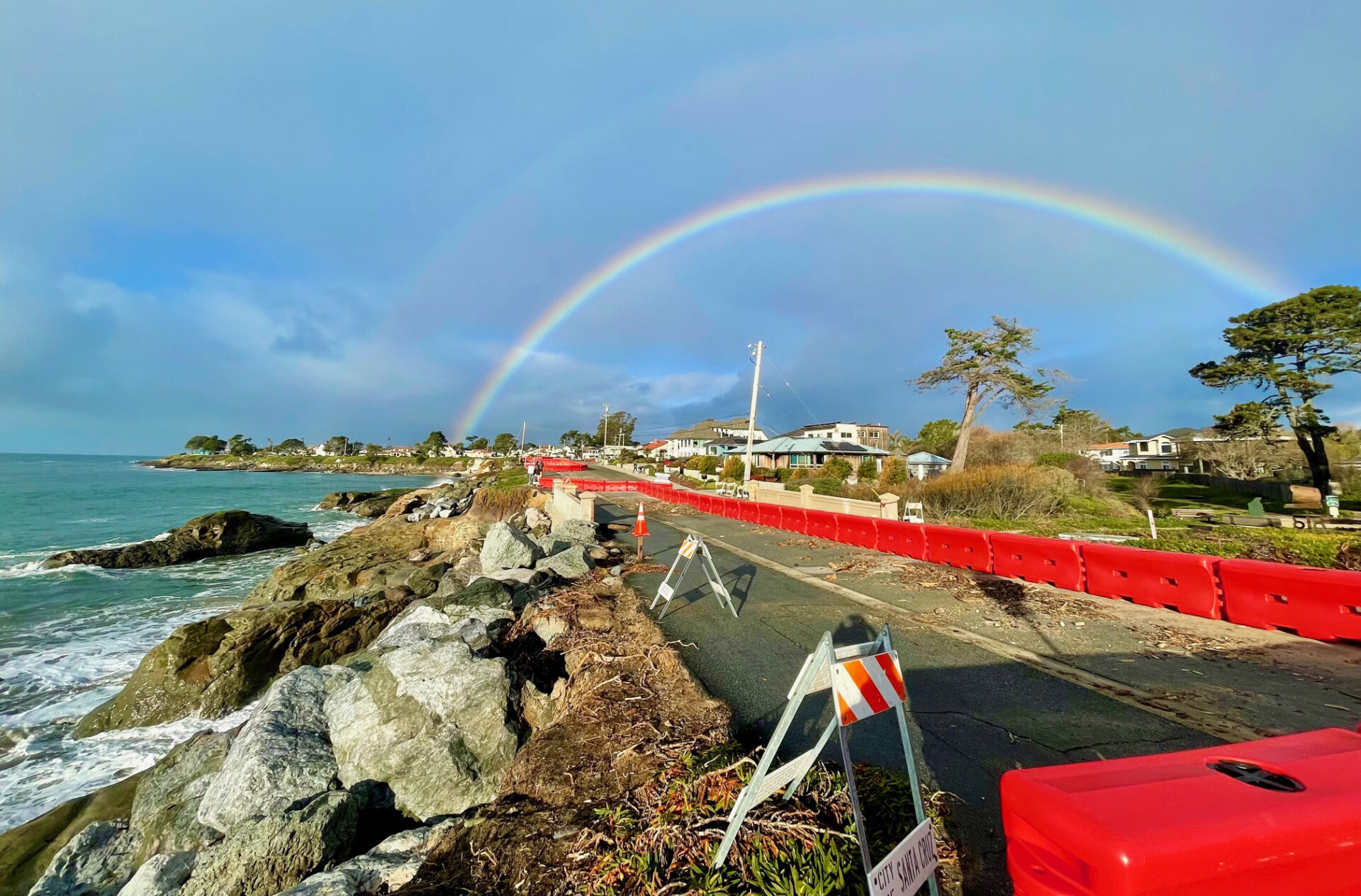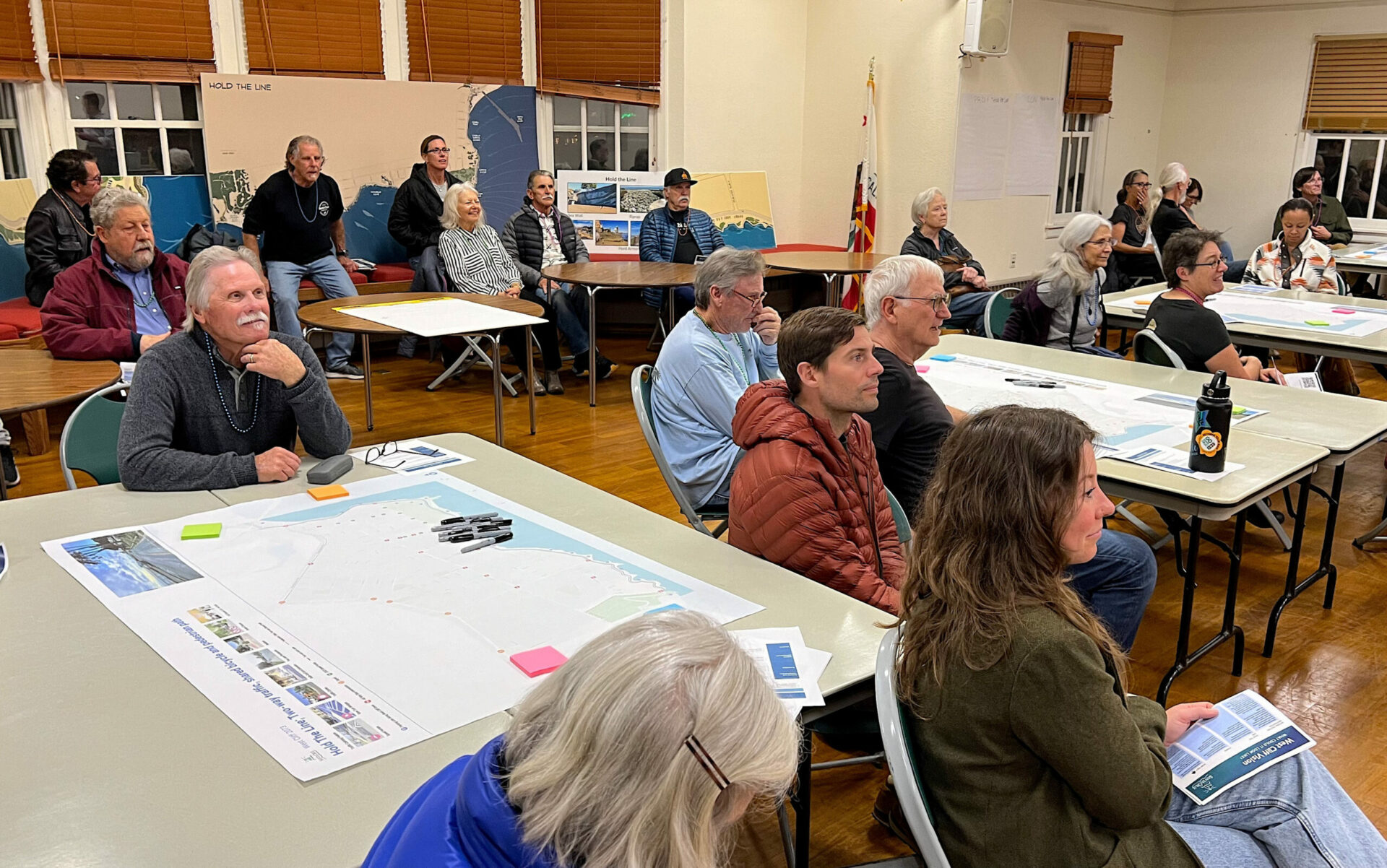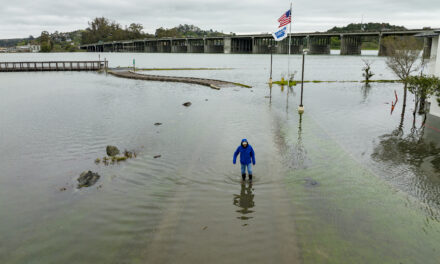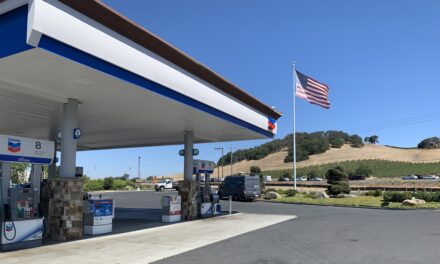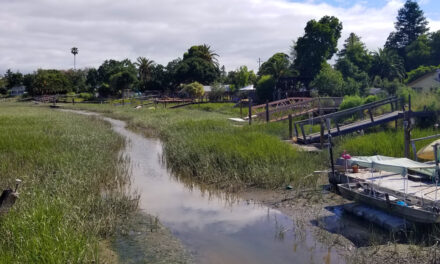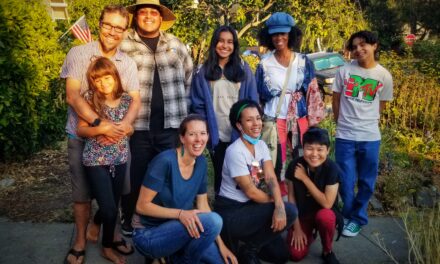Letting the Cliff Crumble
“This is about our next generation and the generation after; it’s not really about this current generation that lives and plays and works along West Cliff.”
The city of Santa Cruz is a vibe. This laid back, idyllic coastal community is best known for surf, sand, and sun. Only a 40-minute drive south from Silicon Valley, Santa Cruz sits at the north corner of Monterey Bay. Its natural beauty and close proximity to the San Francisco Bay Area attract tech moguls, nature lovers, modern hippies, and no fewer than a couple thousand tourists on any given day.
While the city’s long border with the Pacific Ocean makes it an attractive place to live or visit, it also places Santa Cruz at the frontlines of sea level rise and coastal erosion — a fact made abundantly clear in early 2023, when enormous chunks of the city’s iconic West Cliff Drive crumbled into the sea after being pummeled by intense storm waves for hours. The damage left a gaping hole in the road and served as a warning sign of how climate change will impact this treasured stretch of coastline.
“Are we going to do nothing, or are we actually going to take responsibility and try to do something for the generations that follow?” Al Ramadan, Santa Cruz resident, says.
As a community of nature-minded, eco-friendly folks, Santa Cruz has been working on climate adaptation plans for many decades, preparing for a retreating coastline and increasingly intense storms. But no one thought the need would be immediate.
“This storm destroyed us to a level that we didn’t think we were going to have to face for quite a while,” says Assistant City Manager Laura Schmidt.
The city swung into action. Within one year, the city manager’s office crafted a community-driven 50-Year Vision to serve as a formal guide for future development and planning along the coast. The City Council voted to adopt the plan in April 2024.
The 50-Year Vision is a publicly well-received road map for climate adaptation, but experts warn the realities of implementing changes such as hard armoring and planned relocation of developments will be a hard sell.
Beloved West Cliff
While the iconic West Cliff Drive is a road in name, the locals consider it to be so much more. The 3 miles of walkway and park along the cliffs is a hub for community and relaxation.
Erosion here is inevitable. The cliffs are made up of two main layers of rock. The lower layer, called Santa Cruz mudstone, is harder and less prone to erosion. Resting above the mudstone is Purisima, a softer sedimentary rock formation prone to cracks with any small tectonic shift.
The geology of the cliffs isn’t the only erosion factor. The average wave direction down the coast largely protects West Cliff from feeling the full force of the waves. But large storms with powerful winds can switch the angle of the waves, throwing them at the cliffs with their full power. As the climate shifts, storms are growing more powerful, and large erosion events become more common.
Conservation of the West Cliff area as a community space began in 1972. The City of Santa Cruz had proposed a new conference center at Lighthouse Point, but surfers in the community quickly began campaigning against the idea. By 1974, they got an ordinance forbidding the building of the center on the ballot, and it passed with a 75% vote.
This measure began a community culture of rejecting changes on West Cliff. In the following years, residents shut down initiatives to build hotels and parking lots, as well as initiatives to relocate the Mark Abbott Memorial Lighthouse from its precarious spot on the edge of a point on the cliffs. Then, in 2021, the City of Santa Cruz adopted the West Cliff Drive Adaptation and Management Plan, which aimed to develop a series of community supported coastal management projects for the area.
But the destructive storms between December 2022 and January 2023 made the need for protective action on West Cliff more pressing. Within a three week period, a series of nine intense rainstorms — called atmospheric rivers — dumped trillions of gallons of water on California. The storms hit Santa Cruz County the hardest.
Already battered and drenched, Santa Cruz got hit in the first week of January 2023 by a severe storm known as a bomb cyclone. Bomb cyclones, named for their explosive development pattern, bring torrential rains, high winds, and strong surf. The storm was perfectly positioned to deliver maximum damage to Santa Cruz. It changed the usual swell direction, and funneled powerful waves directly at the cliffs.
“[The storm] basically broke the road, broke the cliffs, broke a whole bunch of access points,” Ramadan says of the view on West Cliff the morning after. City agencies estimate the storm swept some 4,000 tons of boulders from the cliff, causing a 120-foot stretch of the heavily-traveled road above to collapse.
For Ramadan and many others in the community, the disaster meant it was time to take action. He teamed up with fellow Santa Cruz residents including ex-mayor Hilary Bryant, CEO of the nonprofit Save the Waves Coalition Nik Strong-Cvetich, and professional surfer and surf shop owner Bob Pearson, to form Save West Cliff, a community organization that aims to conserve West Cliff for future generations.
Playing the Long Game
After the storm, Santa Cruz didn’t waste any time getting to work on repairs. As the city completed emergency stabilization of the road during the first month after the storm, Save West Cliff began promoting the idea of a shared West Cliff Vision.
On the city government side, officials quickly realized this wasn’t a singular issue the public works department could tackle on its own, says Schmidt. The manager’s office reached out to Farallon Strategies, a consulting firm that specializes in helping communities address climate change related challenges and changes.
Before the 2022-2023 storms, the city already had climate adaptation plans in place, but the general public had little awareness of those plans because most people aren’t interested in reading technical documents, Schmidt says. “Part of the thing that they love fell into the ocean and they just want to know what we’re going to do about it,” she says. City leaders needed to act, but they aimed to do it in a way the whole community could understand and support.
With assistance from the Farallon Strategies team, the city hosted numerous informational workshops and surveyed thousands of community members to gauge their priorities and strategize ways to save the crumbling coast. “Our community’s passion for sustainability and habitat preservation really shone through,” Schmidt says.
Building on the community input, the city composed a 50-Year Vision for West Cliff. The 77-page document is filled with photographs, maps, diagrams, and simple-language summaries.
Key aspects of the vision include prioritizing pedestrian and bike access, limiting hard armoring of the cliff, exploring nature-based solutions to decrease the rate of erosion, and relocating certain developments. The vision also outlines implementation steps, with first and second updates to the vision to occur after five years, and following updates to occur every 10 years.
Approaching residents about developing a 50-year plan, rather than a 10- or 20-year plan, is a bit unusual for city planning, says Michael McCormick, president of Farallon Strategies. But it turned out to be a compelling way to get the conversation started, he says, as the community realized “this is about our next generation and the generation after; it’s not really about this current generation that lives and plays and works along West Cliff.”
In early April 2024, the Santa Cruz City Council made a motion to adopt the 50-Year Vision, but the City Manager’s Office brought in a last minute addition to the agenda item. This motion aimed to pilot turning West Cliff Drive into a one-way road for vehicle access, and converting the second lane into bicycle and pedestrian access. Seeing as West Cliff Drive has been a two-lane road for more than 40 years, neighbors were concerned that such a change could funnel traffic into the surrounding neighborhoods. Though community surveys showed overall approval for a one-way road, which could be the first step in a managed retreat strategy for Santa Cruz, West Cliff residents thought it was too sudden.
“The energy in the room was incredibly charged on a very hot topic, and it detracted from the amazing progress that the city and the community had made,” says Ramadan, who was frustrated by the last minute addition to the meeting. After many hours of public comment (which overwhelmingly disapproved of the one-way pilot study) the City Council voted to adopt the 50-Year Vision, but left the one-way pilot behind.
The city council meeting also established a subcommittee tasked with building a 50-year Vision implementation team and a non-West Cliff-specific climate and resilience advisory body. The City of Santa Cruz aims to finalize a 10-year implementation plan for West Cliff by the end of 2024.
Rough Seas Ahead
When it comes to getting the public on board with the idea of having to make changes to West Cliff, the 50-Year Vision can be seen as a success. “I think people were generally really excited about having the opportunity to put something on paper that represented a future state, because so much of the work that’s happened on West Cliff in the past 100 years has been reactive to the environmental conditions that the city is forced to deal with,” says McCormick.
Cliffs, however, are tougher to manage and save than other kinds of eroding shores. And some local experts, like University of California, Santa Cruz professor and coastal geologist Gary Griggs, are skeptical that interventions favored in the vision like “nature-based solutions” could work well for West Cliff.
Video: Save West Cliff
In coastal regions in other parts of the world, the restoration of native mangrove forests or coral reefs will effectively lessen wave power and protect shores from erosion. But Santa Cruz doesn’t have these natural defenses, Griggs says. While there may be potential to work with nature-based solutions in other areas of the Santa Cruz coast, West Cliff’s only defense is sand — beaches that collect the eroded material and dampen wave power. However, these beaches only trap sand where the cliffs have formed a U-shaped divot, preventing the sand from drifting further down the coast. As these sections of cliff shrink, their ability to collect sand shrinks, too.
Some city leaders have floated the idea of artificially extending the cliff in some locations to improve sand retention. However, building directly in the water comes with a new set of hoops to jump through, as more agencies have control of what happens in the water. “It’s also incredibly expensive,” Griggs adds.
Ultimately, Griggs isn’t very hopeful about the conservation of West Cliff. Even hard armoring will only be effective for 10-20 years, he says. “In the long run we’re going to have to move back. Nobody wants to do that. Nobody wants to hear about it.”
Which is exactly why fellow UCSC Professor, Mike Beck, director of the Center for Coastal Climate Resilience, believes “moving back,” also called planned relocation or managed retreat, also isn’t a viable solution for West Cliff despite the fact it’s another key strategy of the 50-Year Vision. “To me, it’s simply an easy way to kick the can down the road and pretend like it’s actually a strategy,” Beck says. While there are some places where managed retreat could work, they are very limited in where and how they’re done, he says. “It’s a strategy that lacks clarity or cost. It’s mostly a way to avoid direct discussion of the real set of options or the full set of options.”
As the next decade creeps closer, climate experts predict storms will become more frequent, more severe, and cause more damage. “There’s absolutely nothing we can do over the long run to stop the Pacific Ocean,” Griggs says. Parts of West Cliff will crumble again, and the city of Santa Cruz will be left with three choices: “mitigation, adaptation, and suffering,” he says. “We’re already doing some of each. The only question is what the future mix will be.”
No one can say for sure when the next storm will threaten West Cliff. But with the community-backed 50-Year Vision as a guide, the city is ready to implement a variety of solutions that align with the community’s priorities. And with the vision in place, the community is ready to take the next step toward their city’s future, Ramadan says. “Everybody is here at the table, which is a really powerful thing.”
Top Photo: City of Santa Cruz






